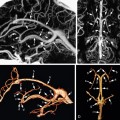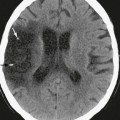CHAPTER 38 Management of the Tumor Patient
BRAIN TUMORS
Epidemiology
Primary brain cancer, those tumors that arise from the substance of brain itself, account for 1% of all cancers.1,2 Approximately 14 per 100,000 people in the United States are diagnosed with primary brain tumors each year. Of these, roughly 7 per 100,000 are diagnosed with a primary malignant brain tumor and will account for approximately 2% of all cancer-related deaths. Brain tumors most commonly occur in the fifth and sixth decades of life but are the second most common form of cancer in childhood next to leukemia. Recently, there has been conjecture that the incidence of brain tumor is increasing. Analysis of this speculation is complicated by diagnostic discrepancies and ascertainment bias in registry data. However, after extensive review, this apparent increase is most likely due to factors such as better diagnostic procedures, improved access to medical care, and enhanced care for the elderly, all leading to greater detection rather than an actual increase in incidence. Nevertheless, more standardized and unbiased diagnosis and registration methods must become established and widely used before such speculation is truly resolved.
Pathology
Primary brain tumors may develop from any of the types of cells found in the brain.3 Tumors may originate from nerve cells or neurons; however, tumors of the supporting cells known as “glial” cells (including astrocytes, oliogodendrocytes, ependymal cells) are more common. A tumor is generally named after the cell of origin. Thus, a tumor derived from glial cells is known as a glioma. To be more specific, a tumor from astrocytic cells is called an astrocytoma and a tumor from the ependymal cells is called an ependymoma. Tumors of the neurons include neuroblastoma, neurocytoma, and ganglioneuromas. Meningiomas are tumors that originate from cells in the meninges. Other tumors include those derived from specialized brain structures such as the pineal gland, pituitary gland, or choroid plexus.
Etiology
The field of molecular genetics is devoted to understanding the changes that transpire in cells that allow them to acquire characteristics of cancer cells and form tumors. Many of these cell alterations have been identified, although the process of how these changes lead to the development of tumors still requires further investigation. A variety of statistical and environmental associations have been made, but no chemical or environmental agent has been shown to cause brain tumors. Several genetic abnormalities in genes governing growth factor–signaling pathways or cell-cycle control are evident in glioma. Discovering how and why these genetic mutations occur may lead to an improved understanding of the disease and to better treatments.
The undifferentiated character of brain tumors and recent investigation into cancer stem cells has fueled debate as to whether neural stem cells give rise to brain tumors via acquisition of oncogenic mutations. Until relatively recently, the adult brain was thought to be a static environment. It is now known that several regions of the brain contain cells capable of proliferation. Such cells are either stem cells (multipotent and self-renewing) or progenitor cells (self-renewing precursors capable of producing astrocytes or oligodendrocytes). Thus, either stem cells or progenitor cells, in addition to differentiated glia, could be the substrate for neoplastic transformation into brain tumors.4
Screening
There are no useful screening measures to detect a brain tumor in otherwise healthy people.
Clinical Presentation
Frontal lobes of the brain: Tumors in the frontal lobe often cause changes in decision-making ability or mood. If the left frontal lobe is involved, the patient may experience difficulty with speaking.
Temporal lobes of the brain: A tumor in the left temporal lobe may lead to difficulty understanding speech, whereas right-sided lesions may disturb the perception of musical notes or quality of speech. Temporal lobe involvement may also cause olfactory or gustatory seizures in which the patient experiences odd smells or tastes; these events may be accompanied by lip smacking or licking movements and an impaired level of alertness. More generalized involvement of the temporal lobes may lead to emotional changes, behavioral difficulties, and auditory hallucinations.
Parietal lobes of the brain: Tumors of the parietal lobe may cause loss of sensation or sensory seizures. Sensory loss may result in the feeling of numbness on one side of the body or an inability to detect where one’s limbs are without looking at them with the eyes. If the left parietal lobe is affected, the patient may experience difficulty with reading or writing.
Occipital lobes of the brain: Tumors of the occipital lobe generally produce partial or total loss of vision. Involvement of the left occipital lobe can result in an inability to recognize colors.
Cerebellum: In the case of cerebellar tumors, if the middle of the cerebellum is affected, the patient will experience difficulty with balance while standing. If one of the hemispheres of the cerebellum is affected, the patient will experience incoordination of the ipsilateral arm and leg.
Brain stem: Tumors affecting the brain stem generally manifest as double vision, difficulty with swallowing, cranial nerve deficits, or weakness of the arms and legs.
Spinal cord: Patients with primary spinal tumors generally present with pain in a portion of the body or of an arm or leg. The onset of symptoms may be gradual or fast, and generally one side of the body is more affected than the other. The exact set of symptoms depends on which spinal cord level is affected. In general, cervical spinal cord tumors affect the arms, shoulders, and neck regions. Thoracic or truncal tumors affect the abdominal muscles and region. Lumbosacral tumors may affect the legs, pelvic region, and bladder.
Treatment
• Most brain tumors range from a low- to high-grade type (the grade of each tumor is based on its microscopic features and determines the type of treatment and prognosis).
• Even the most aggressive or malignant brain tumors rarely metastasize outside the CNS.
• The location of a tumor often determines whether a neurologic deficit occurs.
• Even tumors regarded as slow growing or benign can produce symptoms as severe and life threatening as malignant tumors. This is because they may occur in a vital area of the brain or because when they reach a critical size there is no room for them to expand within the surrounding skull, which puts significant pressure on key structures.
• The brain has no lymphatic vessels to remove the treated or dead tumor, so the tumor may not appear to shrink on CT or MRI even if treatment is successful.
• Treatment of a tumor can result in a new neurologic deficit. For example, a temporary or permanent loss of function can occur after surgery and problems of brain swelling can occur during radiation treatments.
• Unless a dramatic, early and sustained improvement occurs after therapy, it may be difficult to determine the response to treatment. Treatments may produce temporary neurologic deterioration that might take weeks or months to improve.
Radiation Therapy
Radiation therapy is commonly used in the treatment of both primary and metastatic brain tumors.5 The treatments are designed to maximize the lethal effects of radiation on the tumor and minimize the harmful effects to the surrounding brain. Whole-brain irradiation is rarely indicated for most brain tumors. Instead, computer-generated models are used to plan the dose and area of irradiation in a pattern that is “conformal” to any residual tumor not removed during surgery and to a margin surrounding the tumor and surgical cavity. Radiation treatments are generally given once a day, 5 days a week, for up to 6 weeks. A patient then generally receives a 2- to 3-week break from any type of therapy before subsequent imaging studies (e.g., MRI) are performed to assess whether the tumor responded to radiation. Some patients may experience fatigue during radiation therapy; others may develop neurologic problems such as headaches or weakness related to irradiation-induced brain swelling. If such swelling occurs, the problem is usually brief and may be treated with corticosteroid medication to alleviate the swelling.
Chemotherapy
Chemotherapy may be effective and is frequently used before, during, or after surgery and irradiation.6 It can also be used at the time of diagnosis and for a recurrence. Some tumors in the brain can be exquisitely sensitive to chemotherapy, including germ cell tumors, lymphomas, and some oligodendrogliomas. One difficulty in treating brain tumors with chemotherapy is that the drugs do not easily pass through the blood vessels in the brain into the brain parenchyma where the tumor is located. Some experimental approaches have investigated ways to open this blood-brain barrier with drugs, whereas others have attempted to directly inject drugs into the major arteries feeding a tumor. Additional research is ongoing on developing strategies for injecting antitumor agents directly into the brain.
Management by Tumor Type
Astrocytoma
Astrocytomas are categorized by their grade of malignancy.7 The WHO II classification of astrocytoma includes low-grade astrocytoma (grade I or II), anaplastic astrocytoma (grade III), and glioblastoma multiforme (grade IV).
Grade I Astrocytoma (Juvenile Pilocytic Astrocytoma)
• Epidemiology: This tumor is more common in children and younger adults than older adults.
• Clinical Presentation: Patients afflicted by this tumor often present with seizures.
• Location: It is commonly located in the cerebellum, brain stem, optic nerve, or hypothalamus.
• Molecular Biology: None is established.
• Pathology: A biphasic pattern of compact, bipolar cells and loosely textured multipolar cells is seen.
• Treatment: This tumor is often treated only with complete surgical removal. However, even these patients must obtain serial MR images to make sure that the tumor does not recur. When surgery is not possible or it is unable to completely remove a juvenile pilocytic astrocytoma then irradiation or chemotherapy may be considered.
• Prognosis: A greater than 90% 10-year survival for patients with gross total resections is reported.
Grade II Astrocytoma (Low-Grade Astrocytoma)
• Epidemiology: These tumors occur primarily in young adults aged 30 to 50 and comprise 25% of all gliomas.
• Clinical Presentation: Patients present with seizures or headaches.
• Location: The tumors generally occur in the superficial temporal lobes or insular regions but may appear at any location.
• Molecular Biology: There is amplification of 8q, with mutations of 17p associated with TP53.
• Pathology: Well-differentiated astrocytes are seen with nuclear atypia. Mitotic figures, microvascular proliferation, and necrosis are absent. Gemistocytic astrocytoma is a variant with the tendency to rapidly progress to higher grade astrocytoma.
• Treatment: Surgical resection is followed by irradiation or chemotherapy. Those patients who have a gross total resection may be followed with serial MR images until they have evidence of recurrence. When surgery is not possible or it is not possible to completely remove a low-grade astrocytoma, irradiation is generally performed, although some patients elect chemotherapy instead despite limited data on the efficacy of this approach.8
• Prognosis: Median survival is 5 to 7 years with treatment.
Anaplastic Astrocytoma (Grade III Astrocytoma)
• Epidemiology: These tumors mostly occur in adults aged 30 to 50.
• Clinical Presentation: Features depend on location.
• Location: Numerous locations are reported.
• Molecular Biology: Sixty-five percent of cases are due to chromosome 10 deletion. Losses of 9p, 13q, and 17p are common and affect tumor suppressor genes CDKN2A, RB, and TP53, respectively.
• Pathology: There is a greater degree of nuclear atypia than with grade II tumors and mitotic activity. No necrosis is present.
• Treatment: Surgical resection is followed by irradiation and concurrent temozolomide chemotherapy, followed by adjuvant temozolomide. The extent of resection does not influence the choice of subsequent treatment.
• Prognosis: Mean survival is 18 to 36 months with treatment. At recurrence, these tumors may transform to grade IV astrocytoma.
Stay updated, free articles. Join our Telegram channel

Full access? Get Clinical Tree




